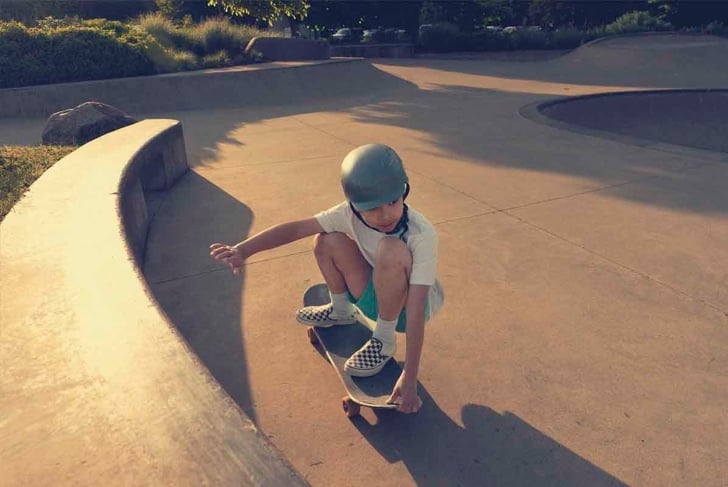The Risk Talk: Why Every Kid Needs One
Help your kids spot good risk from bad before life does it for them

Risk-taking is all too often framed as reckless, or even deadly. But in childhood and adolescence, the right kinds of risks are essential. From trying out for the soccer team to raising a hand in class, strategic risk-taking builds confidence and mental well-being.
Western society has grown increasingly fearful of letting kids fall and fail. The result? Teenage boys are significantly more likely to engage in impulsive, negative risks, while teenage girls tend to shy away from positive risks—especially among friends, out of fear of failure. Education about the importance of positive risk-taking is key to changing the tide.
What is risk-taking?
“Risk,” by its very definition, is the chance that something might happen, for better or worse, from any given decision. But helicopter parenting and safety-first policies have transformed risk into something synonymous with danger. This is a problem, because healthy risk-taking is critical for cognitive development.
Child psychologist and author of The Romance of Risk (Basic Books, 1998), Lynn Ponton, MD, explains: “Risk-taking is the tool an adolescent uses to define and develop his or her identity.”
Supplements for smarter decision-making
|
Supplement |
Potential benefits |
|
B vitamins (especially B6 and B12) |
provide support for cognitive and nervous system function, especially in kids with deficiencies. |
|
has been linked to reduced anxiety and better decision-making. |
|
|
supports healthy growth and development during pregnancy, infancy, childhood, and adolescence. |
Physical versus mental risk
Risk-taking exists on a wide spectrum: physical (like climbing a tree) and social or mental (like auditioning for a play). Both are essential for growth. Risky play, also known as child-led play, blends the two. From navigating conflict with a friend, to jumping off swings, research shows that the health benefits of risky play outweigh the potential for injury.
It teaches resilience and reduces anxiety about the unknown through real-world trial and error.
Boys tend to downplay risks and focus on the thrill, while girls often fixate on consequences. Boys also report feeling more excited than girls do when faced with risk, suggesting in part why they may experience more injuries.
Helpful resources
Try these resources to help your child build positive risk-taking techniques.
- “Risky Play” a guide from Boston University (available from Boston University’s Children’s Center/Family Resources―bu.edu/childrens-center)
- “Risky Decisions―They Can Be a Good Thing for Teens to Make,” a video from the Decision Education Foundation (available from decisioneducation.org)
Risk and gender: boys versus girls
Social norms and parental messaging also play a huge role here. A 2023 study found that British parents allowed riskier play for their sons than for their daughters.
Once children hit puberty, major biological and neurological changes add fuel to the fire. Testosterone spikes in boys may increase competitiveness, while girls’ prefrontal cortexes—the brain’s decision-making centre—mature earlier. As a result, girls may become even more likely to play it safe.
In a recent Pew Research report, 45 percent of US teen girls said they felt pressure to fit in socially, compared to 37 percent of boys, a dynamic that may discourage girls from standing out or stepping up. Over time, that can lead to a confidence gap and a tendency to undervalue their own abilities.
Then and now
Parents of the 1970s were as concerned about their children’s risk-taking as they are today, but has the advent of technology changed this? Back then, the chief worries were associated with alcohol consumption and early sexual activity.
Today, according to an analysis of seven large, nationally representative surveys of 8.3 million US teenagers between 1976 and 2016, teenagers seem to be drinking less now versus then and they also seem to be waiting later to engage in sex. Researchers pointed out, though, that only future surveys will reveal how the age of smart phones and social media has factored into childhood risk-taking behaviours.
Teens and risk
A 2018 marketing research study of 1,400 youth found that 8-year-old girls reported much higher confidence levels than 14-year-old girls did. The survey also found that young girls of all ages were, on average, less confident than young boys.
Negative risk-taking has the potential to lead to negative outcomes, such as substance abuse, injuries, poor health, and even legal issues. On the flip side, excessive caution can lead to a lack of self-confidence, stunted personal growth, or a growing fear of failure.
Overprotection has consequences. Children need to fall—sometimes literally—to learn how to assess risk. Confidence grows through experience, not avoidance. By failing to address the power of positive risk-taking with children, boys may lean into unhealthy risks, while girls may lean away from risks altogether. It’s critical that a healthy balance be found.
Ways to foster healthy risk-taking
Talk about it
Barbara Morrongiello is a clinical psychologist and professor of psychology at the University of Guelph. She says, “Parents and teachers who [integrate] conversations about risk-taking into their daily lives may have long-term sustained effects on children’s attitudes toward risk.”
Incorporate friends
Morrongiello also explains that targeting “friendship pairs,” rather than an individual child, can be a particularly effective way to talk about risk, since friends have such a significant influence on what children do.
Don’t judge
Child psychologist Lynn Ponton, MD, suggests that parents “share what we have learned about risk-taking,” but that “a nonjudgmental and non-bragging manner is critical.” She adds that sharing feelings and mistakes is what’s most important.
Overprotected children are less likely to adequately assess risks. Children learn to handle risks when they are allowed to assess danger, make choices, and recover from failure. Experience is key: the more a child engages with an activity, the more capable they feel of navigating challenges in that realm.
This article was originally published in the August 2025 issue of alive magazine.





